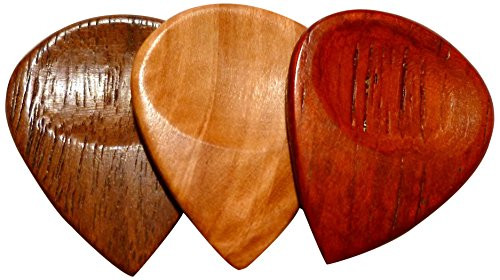Wooden Guitar Picks might be something you’ve heard about in passing, but perhaps haven’t had the chance to try. Like many guitarists, I was curious but hadn’t taken the plunge. So, I decided to explore the world of wooden picks firsthand. In this article, I’ll share my experiences with wooden guitar picks, offering a comprehensive look at their advantages, disadvantages, and unique characteristics. Ultimately, we’ll delve into how to select the perfect wooden guitar pick for your playing style and musical preferences, along with resources for finding quality wooden pick makers.
What are Wooden Guitar Picks?
As the name suggests, wooden guitar picks are crafted from wood. To ensure durability, these picks are typically made from hardwoods. Popular choices include Rosewood, Maple, and Ebony, known for their density and resilience. Similar to picks made from plastic-based materials, wooden picks are available in various shapes and thicknesses. However, the range of shapes and sizes might be slightly less extensive compared to their plastic counterparts.
But why consider using a guitar pick made of wood? Here are compelling reasons that might make you switch:
1. Unmatched Comfort and Feel
One of the first things you’ll notice about wooden picks is their exceptional comfort. The natural, organic texture of wood provides a warm and pleasant feel in your hand, offering a tactile experience that many players find superior to the often slick feel of plastic picks. This enhanced grip can lead to more relaxed and controlled playing sessions.
2. A Distinct and Warm Tone
Wooden guitar picks are celebrated for producing a warm, mellow, and distinctly “woody” tone. This sonic signature sets them apart from the brighter, sometimes sharper sound of plastic picks. The unique tonal character of wood can add depth and richness to your guitar playing, making it particularly appealing for certain musical genres and playing styles.
3. Eco-Friendly and Sustainable Choice
In an increasingly environmentally conscious world, wooden guitar picks offer a sustainable alternative to plastic picks. If sourced responsibly, wood is a renewable resource. By choosing wooden picks, you’re opting for a more eco-friendly option compared to petroleum-based plastic products, contributing to a more sustainable approach to music gear.
Hands-on Testing: Rosewood, Padauk, and Maple Wooden Picks
To begin my exploration of wooden picks, I ordered the Trillogy Sampler Grip set from US Blues. This sampler pack included three picks, each crafted from a different wood species: Rosewood, Padauk, and Maple. These picks featured a contoured design, with a thumb impression on one side and a finger groove on the other. US Blues also offers non-contoured versions for players who prefer a completely flat surface.
Before trying them out, I had some preconceived notions about wooden picks, and some of them were quickly dispelled:
- Misconception: Wooden picks are heavy. I assumed wood picks would feel substantial and weighty. However, despite being thicker than my usual plastic picks, the US Blues wooden picks were surprisingly light and comfortable to handle.
- Misconception: They won’t feel much different from plastic. I expected a minimal difference in feel. I was wrong! The natural, organic texture of real wood provides a unique and noticeably different tactile experience compared to plastic.
- Misconception: All wood types will sound the same. I anticipated similar tonal qualities across different wood species. Again, I was surprised. Each wood type produced distinct and discernible tonal variations.
The Sonic Landscape of Wood Picks
I put these wooden picks to the test across a range of my guitars, including a Telecaster, Stratocaster, hollowbody electric, and a Taylor solid-wood acoustic guitar. To establish a clear point of comparison, I frequently switched back to my familiar plastic pick – the Dunlop Ultex Jazz III XL, made from Ultex material.
Immediately, the tonal variations between the wood types became apparent. Contrary to my initial assumption, the Rosewood, Padauk, and Maple picks each possessed a unique sonic character. While Rosewood and Padauk were tonally quite close, Maple stood out as the most distinct.
Wood density might be a key factor contributing to these tonal differences. Rosewood has a density of approximately 52 lbs/ft3, Padauk at 47 lbs/ft3, and Maple at 44 lbs/ft3.
My observations aligned with my understanding of wood properties. Rosewood, being the densest, produced the highest volume and a brighter tone, consistent with Rosewood’s reputation for treble response. Padauk, slightly less dense, was a close second in volume and offered a slightly warmer treble. Maple, the least dense of the three, exhibited a noticeably softer output compared to both Rosewood and Padauk. Bass response remained relatively consistent across all three wood types. For more insights into the tonal characteristics of Rosewood and Maple, you can refer to our article on guitar fretboard woods.
Wooden Pick Tone on Acoustic Guitar: Strumming and Single Notes
The first thing that struck me was how fantastic wooden picks sound for strumming on an acoustic guitar. They impart a percussive quality to the attack that I hadn’t experienced with plastic picks. It’s a “chick-a-chick-a” sound that’s surprisingly pleasant and adds a rhythmic dimension to strumming patterns. It’s almost an effect in itself, lending a unique rhythmic accent.
Playing single note lines on acoustic was interesting, though less dramatically different than strumming. The note attack possesses a quality that’s subtle and hard to pinpoint. It’s not a negative sound, just distinct. It’s warm, but not in the same way a nylon pick (nylon pick) produces warmth. The Maple pick had a slight nasally quality, while Rosewood offered the brightest tone, and Padauk was a touch warmer than Rosewood.
Wooden Pick Tone on Electric Guitar: Amplified Percussion and Humbuckers
For electric guitar testing, I used my Quilter SuperBlock US amplifier.
I find the Quilter to be a transparent and revealing amp, and my acoustic observations about each wood type largely held true when amplified. In some ways, the tonal differences were even more pronounced, especially on my Telecaster with a clean tone. The Rosewood pick had the most presence and slightly more volume than the Padauk. Maple remained the softest and least bright of the three.
 US Blues T3-GripAC Samplers Grip Wood Trilogy Acoustic Guitar Picks
US Blues T3-GripAC Samplers Grip Wood Trilogy Acoustic Guitar Picks
However, the most intriguing contrast was the percussive strumming sound’s behavior through an amplifier. On acoustic guitar, this sound blends seamlessly with the instrument’s natural resonance. In contrast, when playing through an amp, the percussive string noise becomes distinct from the amplified sound. The percussive element is separate from the tones captured by the pickups and projected by the amp. Consequently, I perceived far less of the percussive strumming sound on electric guitar compared to acoustic.
I particularly enjoyed wooden picks with humbucker pickups. The Seth Lover pickups in my hollowbody guitar sound fantastic, but humbuckers are generally less articulate than single-coil pickups. The US Blues wooden picks, especially the Rosewood, seemed to enhance the woody warmth of the humbuckers while adding some articulation. Rosewood again stood out as the most articulate and loudest. Interestingly, the Maple pick performed surprisingly well on this guitar, producing a pleasantly mellow and full tone. Padauk occupied a middle ground, offering a balanced sound.
Wood Pick Tone Recap:
- Rosewood: Delivers the highest volume, clarity, and presence, offering a bright and articulate tone.
- Padauk: Provides a slightly warmer tone than Rosewood while retaining good clarity and a balanced sonic profile.
- Maple: Produces noticeably less volume and a slightly nasal tone, offering a softer and warmer sound, particularly suitable for mellow tones.
Durability Considerations
One aspect I haven’t fully explored in this initial review is long-term durability. My testing period hasn’t been extensive enough to thoroughly assess wear and tear. I have noticed what appears to be slight wear on the edge of the Maple pick, but it could simply be a surface discoloration, as Maple is a light-colored wood. I plan to continue using these picks to provide an update on their durability in the future.
Where to Purchase Wooden Guitar Picks
You might be surprised by the number of companies specializing in wooden guitar picks. Besides US Blues, here are a few other notable brands:
1. US Blues: Wide Variety and Sampler Packs
US Blues offers an extensive selection of wooden picks, featuring various wood types and wood combinations. Their sampler packs, like the one I tested, are an excellent way to explore different wood tones and find your preference.
US Blues T3-GripAC Samplers Grip Wood Trilogy Acoustic Guitar Picks
2. Timber Tones: Alternative Materials and Exotic Woods
Timber Tones boasts a diverse range of alternative material picks, including various woods, as well as leather, stone, and horn. They are known for using exotic woods and offering unique pick designs. You can find Timber Tones picks on their website.
3. Tree Picks: Affordable Options and Diverse Wood Choices
Tree Picks provides a nice selection of competitively priced wooden picks made from Ebony, Teak, Padauk, and other woods. Their sampler pack is on my list for future reviews, as their diverse wood selection and price point are appealing.
Final Thoughts: Embrace the Wooden Pick Experience
If you haven’t yet experimented with wooden guitar picks, I highly recommend giving them a try. It’s less about whether wooden picks are “better” than plastic, and more about appreciating their unique tonal and tactile qualities. I particularly enjoyed the percussive strumming sound on acoustic guitar. While you might sacrifice some of the crisp articulation of certain plastic picks, you gain a distinctive percussive attack combined with a warm, organic tone. And sometimes, that specific sonic character is exactly what you’re looking for.
When it comes to wood choice, experimentation is key. The three woods I tested (Rosewood, Padauk, and Maple) each offered distinct sonic flavors, and I’m intrigued to explore other wood types like Ebony and Cocobolo. While the Maple pick was the most sonically distinct and perhaps least versatile of the three, its soft warmth proved to be a valuable asset with my hollowbody guitar. Wooden picks may not entirely replace my go-to plastic picks, but they have definitely earned a permanent place in my pick collection as a valuable and tonally inspiring alternative.


